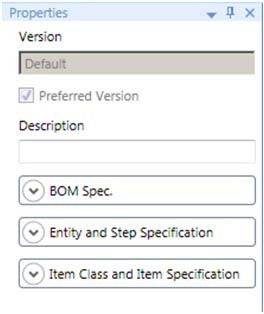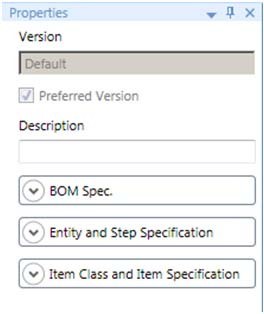Topic 7.2.1 Specifications Overview
Overview
You can assign specifications to operations within a process. Specifications can also be assigned at a global level and can be used as templates by different entities. You can also run specification command in runtime from the Operations Capability Object.
Specifications
Specifications represent a collection of values for settings that can be used during an operation for a process when producing an item for a work order. Specifications are used to set values with optional minimum and maximum values that are used in runtime. Specifications are similar to operating setpoints. For example, when running a job on an entity performing a mixing operation, the specifications for the operation can be used by the Operations Capability Object to load the setpoints in a PLC where the setpoints are different when different items are produced.

You can assign multiple specification versions to an operation. However, you can define only one version as the preferred version. The preferred specification version is used when a work order is created from a process. All operations in a process use that same specification version.

A specification version can contain multiple specifications. When creating a work order from a process, the preferred version is chosen for the job or the user creating the work order can change the specification version for the job if their user group has the May override preferred spec. version privilege.

Configuring Global Specifications
A typical Wonderware MES system contains definitions of many specifications some of which are considered to be “global” that can be used as a template for different items, processes, and entities. The definition of these global specifications is the starting point before they are assigned to operations within a process. These specifications are assigned to specification groups that are valuable when the specifications are used for a process or in the Operations Capability Object.

When a specification is assigned to an operation’s specification version, it is given the values relevant to that item-operation-entity-bill of material combination.

Using Specifications
In the Operations Capability Object, you use the Specifications tab to browse and select the globally configured specifications from the MES database.
In the Operations Capability Object, you can enable the Specifications tab in the object editor via the Enable Specifications checkbox on the General tab. This lets you map the specification properties such as Value, Minimum Value, and Maximum Value to object attributes.
When you execute the specifications commands in the Operations Capability Object, the specifications mapped as attributes in the Galaxy are made available for the Operations Capability Object in runtime. The mapped specification values are retrieved from the database for the Operations Capability Object’s currently running job or a future job.
For the Load Running Job Specs Command for the Operations Capability Object, the specifications for the currently running job on the parent entity of an Operations Capability Object are loaded. In case of the Load Job Specs Command, the Operations Capability Object uses the values of work order, operation and sequence number for the Job that might be run in the future to set up the specifications for later use on that job.
Note that the step number is used to enable loading of the specifications for a single step if a number greater than 0 is in the attribute or the number -1 causes the Operations Capability Object to retrieve the specifications for all steps for an operation on a job.
Inside the Operations Capability Object are two sets of attributes created for every specification:
- Working attributes, which are used to let a shop-floor user change the setpoints value within the maximum and minimum limit values specified
- Target attributes, which are used to represent the values currently loaded into a device, such as a PLC, on the shop floor
The shop floor user can change specification properties after loading them from the database and before uploading them to external input or output sources.
Specification Capabilities
In the Operations Capability Object Specifications tab, you will see specification commands in runtime.
You can trigger specification commands in runtime to perform the following commands for specifications.
Load Job Specs Command
This command loads the specifications for a job, which is not necessarily running on the parent entity of an Operations Capability Object. For this command, the Operations Capability Object uses the values of work order, operation, and sequence number in the runtime job filter to load the specifications.
Load Running Job Specs Command
This command loads the specifications for the currently running job on the parent entity of an Operations Capability Object. You must specify the job position to retrieve the specifications. For this command, the Operations Capability Object uses the values of work order, operation, and sequence number for the job position instead of the values in the runtime job filter to load the specifications.
Download Command
This command is used to copy the values of the Working attributes to the Target attributes when applying the Scaling Factor DB To IO for each specification.
Save Command
This command is used to write the working value of each specification to the MES database.
Upload Command
This command is used to read the value configured for the Actual Specification Value attribute and update the target specification value in runtime. The target attribute value is written to the working attribute, Specs.<SpecAlias>.Working.SpecValueActual, while applying the scaling factor, Specs.<SpecAlias>.ScalingFactorIOToDB.
Load Download Job Specs Command
This command combines the action of executing Load Job Specs Command and Download Command.
Load Download Running Job Specs Command
This command combines the action of executing Load Running Job Specs Command and Download Command.
